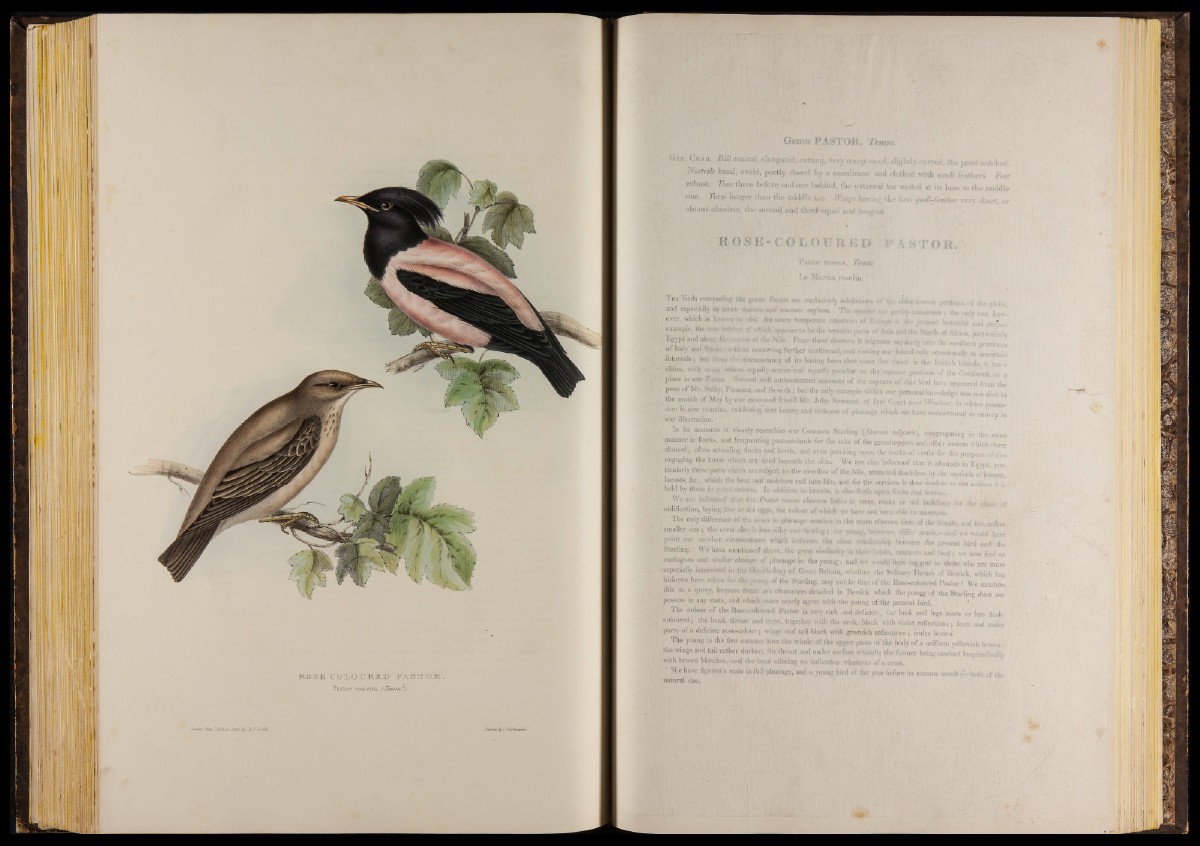
B O S E C O L O U R E D P A S T O R .
Pastor roseus. /Tannv^J.
Genus PASTOR, Tem m ,
G b k . C h a r . B i l l conical, elongated, c u t t i n g l y c o m p n ^ slightly curved, the point notched.
N o strils basal, ovoici, partly closed b y a membrane and clothed with stnall feathers, Feet
robust. Toes three before and one behind, the external toe united at its base to the Huddle
one. T arsi longer than the middle toe. Wings having the first <jmU-fmiher v ery short, or
almost obsolete, the second and third* equal and lo n g e st
R O S E - C O t o U R E D V B T O R . /
Pastor roseus, Tetnxt».
Le M a rtin roseli».
T h e birds cowposiiig the gftntts P a sto r we exclusively inliabi-ianta irf i«;»' -wt-.'.-a,
and especiaBr its mure emuer,, and wunter regions. The spei*.- -,m-: i xoMuento» the „„fly ,nw ' | , r
ever, winch is iitwi-wii to wlr ik e more temperato eiointiriés of - .■ • , ■ , .
, | J I ; '■ , V' .if I IRI cl{!
example, the i f * d t M appears to be the western parts of Asia and the North of Africa, particularly
Egypt and aferar tot rtom t o f (be Nile. From these districts it migrates regularly -into |f c Si,al;Iiern provinces
o f Italy and W t i w *toia occurring further northward, and visiting our Island only occasionally « uncertain
intervals ; Itti;, it tilt v* circumstance Of its having been shot some few tinips in the. Tt.-lrlsl. Mauds i; | ,
claim, with prang ethers « p a lly scarce and equally peculiar to thtf wanner portioij» ó f the 'CbuttVitt r e a
place in i>m; -Fima. Several well authenticated accounts o f the capture o f 1:1* bird have appeared from the
pens o f Mr. Selby, Pennant, and Bewick j but the only e n a p l e within our personal knowledge was « * shot *
the month o f May by our esteemed f r i t t i Mr. John Vewuiau. o f Ivor Court tic-jr Windsor, in whose possession
il-now remains, exhibiting that beauty and riel,„ess o f plumage which we have endeavoured to convcTin
our illustration. i! *
In its manners it closely resembles our Common Starling (.W .-v s m lg vm ), congregating in the same
manner in docks, and frequenting pasture-lands for the sake o f the grasshoppers, and other insects which there
abound ; often attending docks and herds, and even perching upon the backs o f cattle for the purpose o f disengaging
the larvar which are bred beneath the shin. We are also Informed that it abounds in Egypt par
ticularly these purl* -, incl, ,msubject to the overdow of the Nile, attracted d o ,* * * by the m ,riads of ; '
locusts, «se., wUtto tilt heat and moisthre nail into life; add to r the f i f t i e s it thus renders to tlié natives it is
held by then, it, « » * » ,. In additioa to imeett. i t also to e* upon fruits and h em ,..
. y * *J* fio s ftilt: *? ,huir‘T rmm * * » >" * « i» f r e s to ut d i i binlchir., w r Hi. «fere I if
nidification, laying, dry, in; six eggs, the colour of which We have not been siile to ascertain.
T h e oaly difference of tb« scow in plumage conrists in the more obscure tints, ill the »-male, and hixivither
smaller size ; the crest a lo . i'i to n s ilky touting; hie pniug, irinvth1! ljj| d è i I A b i ■ itti I ... would
point out another c i r a tm t o w which UaSom, the dose » f a t t o t i * , « < » -to pièienÉ bird and the
Starling. We have m e iit it » « ! above, the grew: simib ril, in f a i r toil,#», inswwre and tòmi ■ ive now find an
analogous and to ra h r obangi u f plumagg to M l l g and we B i S » ! « $ § • t,, those, who are more
-especially interest«! in .Ilia OibStfolpgy of Great Britain, whether the Solitary Thrush of Bewick, which has
hitherto been token for % jpmg of the Starling, may not be that o f the Rose-coloured, Pastor ? We mention
this as a query, beco,w there ore characters detailed in Bewick which the young of the S ta rlin g docs dot
possess in any state, and which more nearly agree with the young o f the present bird.
The colour o f the Rose-coloured Pastor is very rich and delicate-; tile beak and legs more or less flesh-
coloured; the head, throat and crest, together with 1,1» neck, black with violet reflections ; back and under
parts o f a delicate rose-colour ; wings and tail black will, g rentok reflections ; ¡rides brown.
The young in the first autumn have the whole of the upper parts of the body o f a uniform vellowisb brown •
the wings and tail rather darker; the throat and under s o rto * whitish; the former being marked longitudine«.
with brown blotches,,and the bead offering no indication vviuuct,. of a c re s t
We have figured * male in fu'.l plumage, and a young bird of the year before its autumn monit , - t o l i of il„